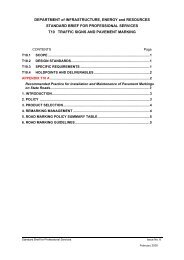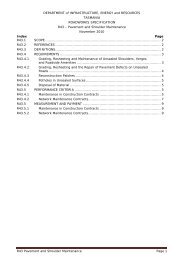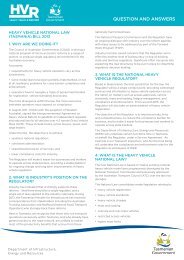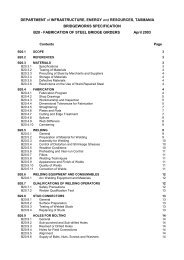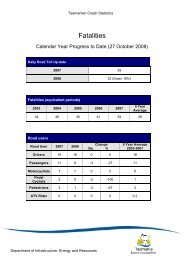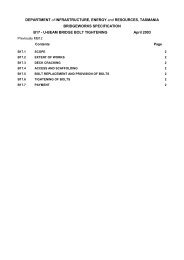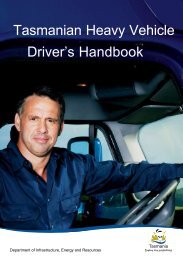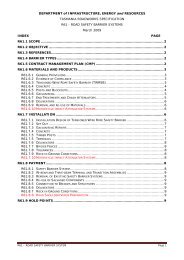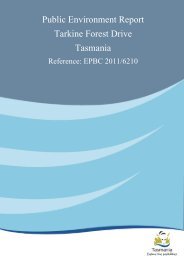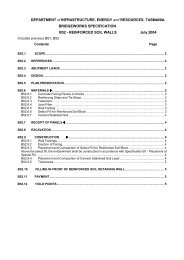- Page 1 and 2: Light VehicleInspection ManualTasma
- Page 3 and 4: ContentsVery Important Advice 9Admi
- Page 5 and 6: 10.5 Visually inspect direct filled
- Page 8 and 9: 8 Light Vehicle Inspection Manual V
- Page 10 and 11: 10 Light Vehicle Inspection Manual
- Page 12 and 13: Tasmanian Inspection Manual for Lig
- Page 14 and 15: Tasmanian Inspection Manual for Lig
- Page 16 and 17: 16 Light Vehicle Inspection Manual
- Page 18 and 19: 2.2 Inspect the condition of visibl
- Page 20 and 21: 20 Light Vehicle Inspection Manual
- Page 22 and 23: NOTES:(1) A 50 mm ball coupling is,
- Page 24 and 25: 4.2 Visually inspect all steering c
- Page 26 and 27: 26 Light Vehicle Inspection Manual
- Page 28 and 29: l) for a passenger car with 4 or mo
- Page 30 and 31: Reason for rejectionNote:a) The are
- Page 32 and 33: first line delete “August 201
- Page 34 and 35: g) The number plate does not face t
- Page 36 and 37: f) Seatbelt webbing that is.1. Dama
- Page 38 and 39: d) the number plate light is not di
- Page 40 and 41: 8.7 Visually inspect the headlights
- Page 42 and 43: c) Electrical wiring is not securel
- Page 44 and 45: 44 Light Vehicle Inspection Manual
- Page 46 and 47: system was installed by the origina
- Page 50 and 51: 10.11 Visually inspect the LPG elec
- Page 52 and 53: 52 Light Vehicle Inspection Manual
- Page 55 and 56: g) All electrical wiring, connector
- Page 57 and 58: 12.10 Visually inspect body panels,
- Page 59 and 60: c) any of the above lights are dama
- Page 61 and 62: 12.25 Visually inspect the exhaust
- Page 63 and 64: Section 13:Motor HomesMotor vehicle
- Page 65 and 66: Section 14:Light Trailers & Caravan
- Page 67 and 68: NOTE:The free play measurement give
- Page 69 and 70: 14.15 Inspect the mudguardsReasons
- Page 71 and 72: Page 11 - Version controlAt the end
- Page 73 and 74: Section 15:Light Vehicle Standards
- Page 75 and 76: h) The tariff indicator lights are
- Page 77 and 78: q) The vehicle is not fitted with a
- Page 79 and 80: Section 16:Light Vehicle Standards
- Page 81 and 82: Section 17:BusesNOTE:The general ro
- Page 83 and 84: Tasmanian Inspection Manual for Lig
- Page 85 and 86: 17.6 Check StepsReason for rejectio
- Page 87 and 88: Appendix A:Brake Drums and DiscsBra
- Page 89 and 90: • For trailers with an ATM up to
- Page 91 and 92: Appendix C:Suspension Modifications
- Page 93 and 94: Appendix D:Lift Kits & SuspensionMo
- Page 95 and 96: Appendix E: GROUND CLEARANCEREQUIRE
- Page 97 and 98: Appendix F:Retreaded TyresThe Trans
- Page 99 and 100:
Appendix G:Windscreen Damage and Re
- Page 101 and 102:
Tasmanian Inspection Manual for Lig
- Page 103 and 104:
Tasmanian Inspection Manual for Lig
- Page 105 and 106:
Tasmanian Inspection Manual for Lig
- Page 107 and 108:
Appendix J:Lighting Standardsa) Lig
- Page 109 and 110:
Appendix K: Headlamp testing Screen
- Page 111 and 112:
Appendix L:LPG and CNG Certificatio
- Page 113 and 114:
Tasmanian Inspection Manual for Lig
- Page 115 and 116:
Tasmanian Inspection Manual for Lig
- Page 117 and 118:
ersion 4 - 1 May 2009 Page 128Light
- Page 119 and 120:
Tasmanian Inspection Manual for Lig
- Page 121 and 122:
Tasmanian Inspection Manual for Lig
- Page 123 and 124:
Tasmanian Inspection Manual for Lig
- Page 125 and 126:
Tasmanian Inspection Manual for Lig
- Page 127 and 128:
Tasmanian Inspection Manual for Lig
- Page 129 and 130:
Appendix N:Missing Compliance Plate
- Page 131 and 132:
Appendix O:Modifications BrochureIn
- Page 133 and 134:
Tasmanian Inspection Manual for Lig
- Page 135 and 136:
Tasmanian Inspection Manual for Lig
- Page 137 and 138:
Tasmanian Inspection Manual for Lig
- Page 139 and 140:
Tasmanian Inspection Manual for Lig
- Page 141 and 142:
Tasmanian Inspection Manual for Lig
- Page 143 and 144:
Tasmanian Inspection Manual for Lig
- Page 145 and 146:
Tasmanian Inspection Manual for Lig
- Page 147 and 148:
Tasmanian Inspection Manual for Lig
- Page 149 and 150:
Tasmanian Inspection Manual for Lig
- Page 151 and 152:
Appendix P:Vehicle Modification Cod
- Page 153 and 154:
D1 Rear Axle/s InstallationD2 Diffe
- Page 155 and 156:
Appendix Q:Checking for RustA.1 Cla
- Page 157 and 158:
NOTE: Because of differing structur
- Page 159 and 160:
Noise Test ProceduresforIn-Service
- Page 161 and 162:
ForewordThe National Transport Comm
- Page 163 and 164:
Table of Contents1. Definitions 160
- Page 165 and 166:
4 Test method for all vehicles exce
- Page 167 and 168:
nominal axis of maximum sensitivity
- Page 169 and 170:
Tasmanian Inspection Manual for Lig
- Page 171 and 172:
Appendix S:Checking Vehicle Identif
- Page 173 and 174:
APPENDIX T:Building Small TrailersN
- Page 175 and 176:
Vehicle Standards Bulletin 11. SCOP
- Page 177 and 178:
Vehicle Standards Bulletin 1c) The
- Page 179 and 180:
Vehicle Standards Bulletin 1(Refer
- Page 181 and 182:
Vehicle Standards Bulletin 1Typical
- Page 183 and 184:
Vehicle Standards Bulletin 111.9 Ho
- Page 185 and 186:
12.9 Width (Overall Width)Vehicle S
- Page 187 and 188:
13. LIGHTING.Vehicle Standards Bull
- Page 189 and 190:
Vehicle Standards Bulletin 113.1 Fr
- Page 191 and 192:
Vehicle Standards Bulletin 1FIGURE
- Page 193 and 194:
Vehicle Standards Bulletin 1FIGURE
- Page 195 and 196:
Vehicle Standards Bulletin 1Note Ma
- Page 197 and 198:
Vehicle Standards Bulletin 1NoteBec
- Page 199 and 200:
16.2 Drawbar Safety ChainsVehicle S
- Page 201 and 202:
Vehicle Standards Bulletin 1A coupl
- Page 203 and 204:
Vehicle Standards Bulletin 119: AXL
- Page 205 and 206:
Semi-trailersVehicle Standards Bull
- Page 207 and 208:
23.3 Structural RequirementsVehicle
- Page 209 and 210:
Vehicle Standards Bulletin 127. USE
- Page 211 and 212:
Vehicle Standards Bulletin 11 Name
- Page 213 and 214:
Appendix U:Light Trailer Requiremen
- Page 215 and 216:
Tow Couplings - 50mm Ball Type Coup
- Page 217 and 218:
6. Axle Rating (including wheels an
- Page 219 and 220:
Appendix VInspection ofTyre Load an
- Page 221 and 222:
Appendix WVSS VEHICLE IDENTIFICATIO
- Page 223 and 224:
VSS VEHICLE IDENTIFICATION AND ENGI
- Page 225 and 226:
VSS VEHICLE IDENTIFICATION AND ENGI
- Page 227 and 228:
VSS VEHICLE IDENTIFICATION AND ENGI
- Page 229 and 230:
VSS VEHICLE IDENTIFICATION AND ENGI
- Page 231 and 232:
VSS VEHICLE IDENTIFICATION AND ENGI
- Page 233 and 234:
VSS VEHICLE IDENTIFICATION AND ENGI
- Page 235 and 236:
VSS VEHICLE IDENTIFICATION AND ENGI
- Page 237 and 238:
VSS VEHICLE IDENTIFICATION AND ENGI
- Page 239 and 240:
VSS VEHICLE IDENTIFICATION AND ENGI
- Page 241 and 242:
VSS VEHICLE IDENTIFICATION AND ENGI
- Page 243 and 244:
VSS VEHICLE IDENTIFICATION AND ENGI
- Page 245 and 246:
VSS VEHICLE IDENTIFICATION AND ENGI
- Page 247 and 248:
VSS VEHICLE IDENTIFICATION AND ENGI
- Page 249 and 250:
VSS VEHICLE IDENTIFICATION AND ENGI
- Page 251 and 252:
VSS VEHICLE IDENTIFICATION AND ENGI
- Page 253 and 254:
VSS VEHICLE IDENTIFICATION AND ENGI
- Page 255 and 256:
VSS VEHICLE IDENTIFICATION AND ENGI
- Page 257 and 258:
VSS VEHICLE IDENTIFICATION AND ENGI
- Page 259 and 260:
Light Vehicle Inspection ManualVers



